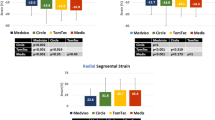Abstract
Left ventricular regional wall motion in ischemic heart disease was evaluated and compared using three different methods based on radiographic ventriculograms. Radial method uses an internal reference system, and centerline method employs an external reference system, both methods are based on two frame analysis. The last method, an automated video intensity technique, analyzes on a frame by frame basis utilizing an external reference system. A total of 42 patients were included in the study, of these 12 had a history of myocardial infarction. Significant coronary artery stenosis was defined as 50% measured diameter reduction. Right coronary artery (29/42) was most commonly involved. Single vessel disease was present in 18 patients, two vessel disease in 15 and three vessel disease in eight patients. The radial method detected abnormal wall motion in 16/42 patients, centerline method yielded a detection accuracy of 22/42 and with the new technique, asynchrony was noted in 39/42 patients. All three methods detected regional wall motion abnormalities with a higher sensitivity in patients with prior myocardial infarction. The centerline method had highest sensitivity for the right coronary artery bed (55%). The radial method (45%) and the video intensity based technique (95%) had the highest sensitivity for regions supplied by the left anterior descending artery.
Similar content being viewed by others
References
Tennant R, Wiggers CJ. The effect of coronary artery occlusion on myocardial contraction. Am J of Physiol 1935; 112: 351–61.
Herman MV, Heinle RA, Klein MD, Gorlin R. Localized disorder in myocardial contraction. New Engl J Med 1967; 277: 222–32.
Bodenheimer MM, Banka VS, Helfant RH. Nuclear cardiology. I. Radionuclide angiographic assessment of left ventricular contraction: uses, limitations and future directions. Am J of Cardiol 1980; 45: 661–73.
Gillam LD, Hogan RD, Foale RA, Franklin TD Jr, Newell JB, Guyer DE, Weyman AE. A comparison of quantitative echocardiographic methods for delinieating infarct-induced abnormal wall motion. Circulation 1984; 70: 113–22.
Higgins CB, McNamara MT. Magnetic resonance imaging of ischemic heart disease. Pro in Cardiovasc Dis 1986; 28: 257–66.
Warren SE, Bhargava V, Vieweg WVR, Dennish GW, Alpert JS, Hagan AD. Semi-automated method for evaluation of left ventricular regional wall motion in coronary artery disease. Am J of Cardiol 1980; 46: 832–6.
Gibson DG, Doran JH, Traill TA, Brown DJ. Abnormal left ventricular wall motion during early systole in patients with angina pectoris. Br Heart J 1978; 40: 758–66.
Fujita M, Sasayama S, Kawai C, Eiho S, Kuwahara M. Automatic processing of cineventriculograms for analysis of regional myocardial function. Circulation 1981; 63: 1065–74.
Marier DL, Gibson DG. Limitations of two frame method for displaying left ventricular wall motion in man. Br Heart J 1980; 44: 555–9.
Bhargava V. A new video intensity based wall motion analysis technique. Comp Med Imaging and Graph 1990; 14: 107–18.
Gelberg HJ, Brundage BH, Glantz S. Quantitative left ventricular wall motion analysis: a comparison of area, chord, and radial methods. Circulation 1979; 59: 991–1000.
Sheehan FH, Dodge HT, Brown BG, Bolson EL, Mitten S. Application of the centerline method: analysis of change in regional left ventricular wall motion in serial studies. Computers in Cardiology IEEE 1982: 97–100.
Sheehan FH, Bolson EL, Dodge HT, Mathey DG, Schofer J, Woo H-W. Advantages and applications of the centerline method for characterizing regional ventricular function. Circulation 1986; 74: 293–305.
Sokal RR, Rohlf FJ. Introduction to biostatistics. WH Freeman and Company, San Francisco, 1973.
Mancini GBJ, Norris SL, Peterson KL et al. Quantitative assessment of segmental wall motion abnormalities at rest and after atrial pacing using digital intravenous ventriculography. J of Am Coll Cardiol 1983; 2: 70–6.
Chappuis FP, Widmann TF, Nicod P, Peterson KL. Densitometric regional ejection fraction: a new three-dimensional index of regional left ventricular function — comparison with geometric methods. J of Am Coll Cardiol 1988; 11: 72–82.
Sheehan FH, Dodge HT, Bolson EL, Woo H-K, Caputo GR, Stewart DK. Value of partial ejection fraction, volume increment, and regional wall motion in identifying patients with clinically significant coronary artery disease. Circulation 1983; 68: 756–62.
Dawson JR, Gibson DG. Regional left ventricular wall motion in pacing induced angina. Br Heart J 1988; 59: 309–18.
Lyons J, Norell M, Gardner J, Davies S, Balcon R, Layton C. Phase and amplitude analysis of exercise digital left ventriculograms in patients with coronary artery disease. Br Heart J 1989; 62: 102–11.
Nissen SE, Booth D, Wares J, Fassas T, DeMaria AN. Evaluation of left ventricular contractile pattern by intravenous digital subtraction ventriculography: comparison with cineangiography and assessment of intraobserver variability. Am J of Cardiol 1983; 52: 1293–8.
Sniderman AD, Marpole D, Fallen EL. Regional contraction patterns in the normal and ischemic left ventricle in man. Am J of Cardiol 1973; 31: 484–9.
Chaitman BR, DeMots H, Bristow JD, Rosch J, Rahimtoola SH. Objective and subjective analysis of left ventricular angiograms. Circulation 1975; 52: 420–5.
Zir LM, Miller SW, Dinsmore RE, Gilbert JP, Hawthorne JW. Interobserver variability in coronary angiography. Circulation 1976; 53: 627–32.
Sheehan FH, Stewart DK, Dodge HT, Mitten S, Bolson EL, Brown BG. Variability in the measurements of regional left ventricular wall motion from contrast angiograms. Circulation 1983; 68: 550–9.
Lew WYW, Ban-Hayashi E. Mechanism of improving regional and global function by preload alterations in the canine left ventricle. Circulation 1985; 72: 1125–34.
Hoit BD, Lew WYW. Functional consequences of acute vs. posterior wall ischemia in canine left ventricles. Am J of Physiol 1988; 72: H1065-H1073.
Holman BL, Wynne J, Idione J, Neill J. Disruption in the temporal sequence of regional ventricular contraction. Circulation 1980; 61: 1075–82.
Author information
Authors and Affiliations
Rights and permissions
About this article
Cite this article
Sunnerhagen, K.S., Smith, S.C., Jaski, B.E. et al. Ischemic heart disease and regional left ventricular wall motion: a study comparing radial, centerline and a video intensity based slope technique. Int J Cardiac Imag 6, 85–96 (1990). https://doi.org/10.1007/BF02398890
Issue Date:
DOI: https://doi.org/10.1007/BF02398890




